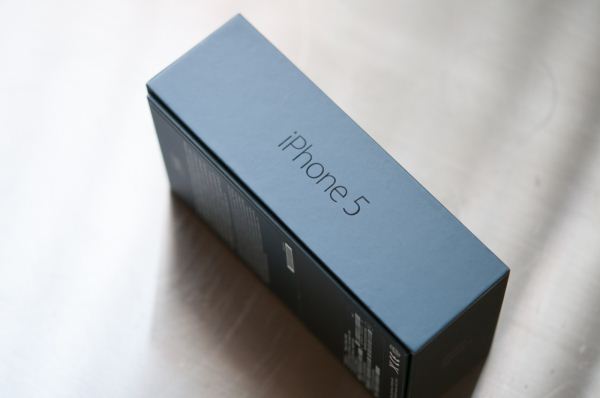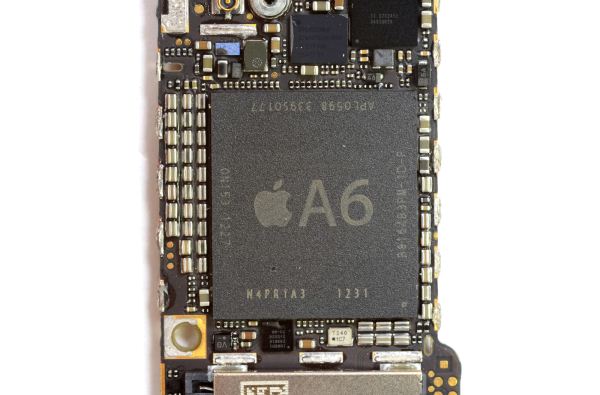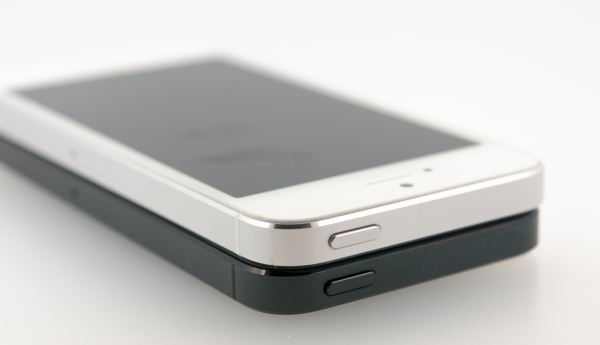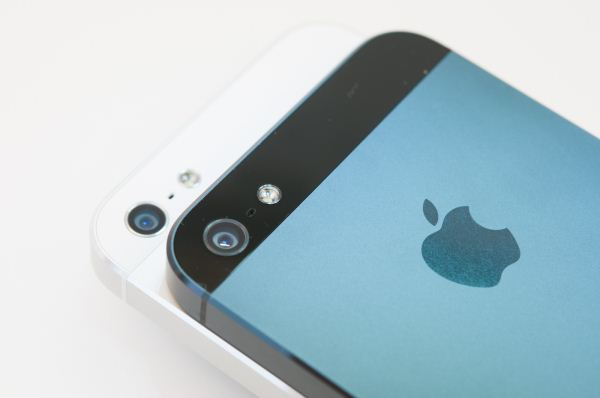The iPhone 5 Review
by Anand Lal Shimpi, Brian Klug & Vivek Gowri on October 16, 2012 11:33 AM EST- Posted in
- Smartphones
- Apple
- Mobile
- iPhone 5
Final Words
With a device vendor that also happens to moonlight as an SoC vendor and software developer we really need three parts to this conclusion. I’ll begin with the silicon, as that’s ultimately what enables the overall experience.
A6 SoC Conclusions
With the iPhone 4S Apple made a conscious decision to shift its annual smartphone release to the latter half of the year. At the same time, Qualcomm’s 28nm schedule put its new SoCs in phones at the earlier part of the year. All indications point to the first Cortex A15 based designs showing up similarly in the first half of 2013. All of this conspires to set the market up for some very interesting leap frogging. Without a major delay that impacts either Apple or its Android competitors, it looks like in the Spring we’ll see Android devices leapfrogging the iPhone and Apple responding in kind in the fall. The staggered release cadence won’t continue forever, but at least for the next generation it appears that will be how it plays out.
I don’t know which refresh cycle makes the most sense (new architectures earlier in the year vs. later) from a business standpoint. I suspect there’s something to be said about hitting the holiday buying season but I’m not much of a financial analyst.
Apple’s decision to introduce a custom ARM core in the A6 SoC is very unique. I would normally have expected Apple to go for a Cortex A15 based design in the next round however I’m no longer sure. Investing in your own CPU design isn’t usually something you do once and then just drop the next generation. I would assume Apple has plans to continue to evolve this architecture in a very power focused way. We’ve mentioned time and time again that ARM’s Cortex A15 was first conceived as an architecture for more power hungry systems (servers and other PC competitors). The Cortex A15 moved down the totem pole and will likely rely on smaller cores to keep power consumption in check when running lighter workloads. It wouldn’t be a stretch to envision a slightly larger (~20%?) Swift core next generation built at Samsung or TSMC, adding some architectural features to drive performance up.
Swift appears to offer better power/performance efficiency than any other currently available ARM architecture. Its architecture, performance and power profile most closely resemble Qualcomm’s 28nm Krait/Snapdragon S4, although through hardware or software optimizations it appears to be able to come out slightly ahead. Apple complicates the gains in performance by increasing clock speed dramatically over the iPhone 4S, which makes the architecture look more revolutionary than evolutionary in nature. A good part of the 2x increase in CPU performance compared to the iPhone 4S boils down to clock speed, however there are significant improvements to the memory subsystem that really help things. ARM’s Cortex A15 will likely pull ahead of Swift in CPU performance, although it remains to be seen how it will compare in power and what Apple will respond with in late 2013.
Intel’s Atom core remains very competitive with the best of the ARM world. A single core Atom still ends up being the only CPU that can regularly outperform Apple’s Swift, however it does so while seemingly consuming more power. Whether the performance advantage can make up for the peak power deficit remains to be seen as we lack a good, high-end Atom based LTE smartphone to really test that theory against.
On the GPU side Apple continues to be at the forefront of innovation, however Qualcomm appears to have learned quickly as the Adreno 320 manages to give the PowerVR SGX 543MP3 a run for its money. I suspect next year we’ll see similarly competitive performance from Intel and NVIDIA as well (finally!). Having an aggressive player in the silicon space always makes for good competition once everyone adjusts their release cadence.
Overall the silicon story in the iPhone 5 is a very good one. Performance increases by the biggest margin since the move from the iPhone 3G to 3GS. If you are the type of user who can appreciate improved response time, the iPhone 5 definitely delivers.
The market is becoming increasingly competitive however. Just as Google responded aggressively to close the UI performance gap between Android and iOS, the SoC vendors appear to be doing the same with their silicon. Going forward it is going to become more difficult to maintain significant performance advantages similar to those Apple has enjoyed in previous generations. It’s really going to boil down to software and ecosystem in the not too distant future.
iPhone 5 Device Conclusions
As a device, the iPhone 5 is a solid evolution of its predecessors. The larger 4-inch screen doesn’t fundamentally change the device, but it definitely modernizes it. Going back to the old 3:2 aspect ratio iPhones feels extremely claustrophobic now. After using the iPhone 5 for weeks, picking up an older iPhone feels a lot like switching between the iPhone 4 and iPhone 3G did.
The new device feels appreciably thinner and lighter, although a tradeoff is the delicate feel of the anodized aluminum on the 5. Although you’d normally assume moving away from glass would make the device feel more rugged, the fear of scratching the very thin anodized coating quickly supplants any relief you might have had. The iPhone 5 lacks the heft that gave the 4/4S that jewel-like feel, but it does so without feeling overly cheap and ends up being an improvement in overall portability. Design is subjective, but I do believe that Apple has managed to move forward in this regard as well.
The iPhone 5 marks Apple’s first integration of LTE into a smartphone, and the process went relatively smoothly. Handovers between 3G and LTE are relatively seamless, although we did notice the occasional dropped hotspot connection when calls came in while we were tethered over WiFi and on LTE. For those of you who haven't yet enjoyed the world of LTE on a smartphone, LTE support delivers one of the bigger performance improvements you’ll see with the iPhone 5.
At a high level, the iPhone 5’s cameras appeared to be some of the least unchanged elements of the new device however in practice the improvements are significant. The front facing camera now delivers much higher quality photos and the rear facing camera's low light performance is a major step forward compared to the iPhone 4S. Given the amount of smartphone photography that happens in poorly lit conditions, I suspect the improvements Apple made to the 5's rear facing camera will be quite noticeable in regular use.
Although the bulk of the discussion on display had to do with its taller aspect ratio and mildly increased resolution, it's really the move to in-cell touch (reducing reflections/glare) and the increase in quality that are most revolutionary here. The iPhone 5's display now offers full sRGB coverage and much better accuracy than its predecessor. Although a subtle improvement in day to day use, it's good to see Apple continuing to push the envelope here.
Battery life, as we mentioned earlier, is really a mixed bag. Depending on your workload you'll either see improved battery life due to the faster platform and a quick rush to sleep or you'll see a regression if you put the new silicon to heavier use as a result of its speed. The days of relatively static battery life progressions are behind us at this point, welcome to the world of increased dynamic range of power consumption. It's a tradeoff that has to be made in pursuit of ever increasing performance unfortunately. Apple seems to maintain good idle power characteristics in light of everything.
The big question is of course whether or not you should upgrade to the iPhone 5. The move to LTE alone is a big enough reason to upgrade for any heavy user of mobile data. The larger/improved display, much faster SoC and 5GHz WiFi support are all icing on the cake - and this is one well iced cake. If you have a subsidized upgrade available via your carrier, I'd say the upgrade is a no brainer. If however you've got to pay full price you have to take into consideration what's coming on the horizon. A faster version will likely hit in late 2013, and we'll potentially see a move to 20nm silicon in late 2014 (paving the way for an improvement in power profile). If you're on a 2 year upgrade cycle, buying the 5 now and upgrading again in 2014 wouldn't be a bad idea.
iOS 6 Conclusions
Finally, we have to conclude our look at the iPhone 5 with a discussion of its operating system. As I’ve mentioned in articles/videos past, Apple and Microsoft find themselves in somewhat similar positions when it comes to the role their smartphones play in the market. Both companies run quite profitable businesses selling Macs and PCs respectively, and as a result their smartphones can act as companion devices rather than primary computing devices. Unless there’s a dramatic change in Chrome OS, Google has to rely on Android smartphones and tablets to get their share of computing dollars (and search results). Apple and Microsoft differ a bit when it comes to tablets as Apple uses the iPad to compete with low-cost PCs.
I believe understanding the motives helps explain the software decisions that are made. As the iPad has to serve as a cheap PC alternative, iOS ends up inheriting some productivity focused enhancements - just not as many as a full blown OS would.
As it applies to the iPhone, iOS serves as a companion platform, a true pocket digital assistant. Its goal is to be an appliance, not a full blown computing device, and as such it looks and feels very different than Android.
With the latest update to iOS, Apple continues to evolve the platform. Similar to the iterative improvement in iPhone hardware, Apple’s yearly iOS cadence is largely responsible for its solid footing in the market. Although a clear regression in iOS Maps quality plagued this latest update, the platform is still a good one for those who it resonates with.
iOS remains very appliance-like in its behavior. Despite the added complexity that iOS has inherited over the years, Apple has been able to retain much of the simplicity that drew users to the platform in the early days. The iPhone/iOS platform is unique in that, unlike OS X, it started as a mainstream platform rather than a computing platform that had to try and become more consumer friendly over time.
If you’re after something fundamentally different, you’ll have to look elsewhere as I don’t believe iOS is destined for a dramatic departure from the current model anytime soon. Thankfully there are good alternatives from both Google and Microsoft if iOS isn’t what you’re looking for. Pressure from Apple on both the hardware and software side will help ensure that those platforms continue to progress as well - competition is alive and well in the mobile industry, that’s for sure.
For existing iOS fans and/or iPhone users, the latest iteration of iOS on the iPhone 5 (perhaps with the exception of Maps) does nothing to alienate you. Apple has done a good job of dutifully maintaining the platform and remaining true to its roots. As a significant source of Apple’s revenue, you would expect no less.















276 Comments
View All Comments
Calista - Sunday, October 21, 2012 - link
English is not my native language (as I'm sure you have noticed) and so the flow in the language is far from flawless. But I still believe my opinions are valid and that the review was too long-winded.Teknobug - Wednesday, October 17, 2012 - link
I live in a big city and I don't know a single person that went and got the iPhone 5, most are happy with the iPhone 4 or whatever phone they're using, I don't see what's so great about the iPhone 5 other than it being built better than the iPhone 4's double sided glass structure (I've seen people drop their's on the train or sidewalk and it shattering on both sides!).And what now? iPad mini? I thought Apple wasn't interested in the 6-7" tablet market, Steve Jobs said 9" is small enough. I know Apple tried a 6" tablet a decade ago but the market wasn't read for it back then.
name99 - Wednesday, October 17, 2012 - link
You know what AnandTech REALLY needs now?A comment moderation system like Ars Technica, so that low-content comments and commenters (like the above) can be suppressed.
Teknobug is a PERFECT example of Ars' Troll Type #1: "Son of the "I don't even own a TV" guy: "
This is the poster who thinks other people will find it interesting that he cares nothing about their discussion or their interests, and in fact judges himself as somehow morally superior as a result. The morphology of this on Ars Technica includes people popping into threads about Windows 8 to proclaim how they will never use Windows, people popping into threads about iOS 6 to proclaim that they never have and never will buy an Apple product, and people popping into Android related threads and claiming that they will never purchase "crappy plastic phones." In these cases, the posters have failed to understand that no one really cares what their personal disposition is on something, if they have nothing to add to the discussion.
ratte - Wednesday, October 17, 2012 - link
yeah, my thoughts exactly.worldbfree4me - Wednesday, October 17, 2012 - link
I finished reading the review a few moments ago. Kudos again for a very thorough review, however I do a have a few questions and points that I would like to ask and make.Am I wrong to say, Great Job on Apple finally catching up to the Android Pack in terms of overall performance? The GS3, HTC X debuted about 6 months ago yes?
Have these benchmark scores from the competing phones been updated to reflect the latest OS updates from GOOG such as OS 4.1.X aka Jelly Bean?
Clearly the LG Optimus G is a preview of the Nexus 4,complete with a modern GPU In Adreno 320 and 2GB ram. I think based on history, the Nexus 4 will again serve as a foundation for all future Androids to follow. But again, good Job on Apple finally catching up to Android with the caveat being, iOS only has to push its performance to a 4inch screen akin to a 1080p LCD monitor verses a true gamers 1440p LCD Home PC setup. Ciao
Zinthar - Thursday, October 18, 2012 - link
Caught up and passed, actually (if you were actually reading the review). As far as graphics are concerned, no smartphone has yet to eclipse the 4S's 543MP2 other than, of course, the iPhone 5.I have no idea what you're going on about with the Adreno 320, because that only gets graphics performance up to about the level of the PowerVR SGX 543MP2. Please see Anand's preview: http://www.anandtech.com/show/6112/qualcomms-quadc...
yottabit - Wednesday, October 17, 2012 - link
Anand, as a Mech-E, I think somewhere the anodization facts in this article got very wonkyI didn't have time to read thoroughly but I saw something about the anodized layer equaling half the material thickness? The idea of having half a millimeter anodized is way off the mark
Typically there are two types of anodizing I use: regular, and "hard coat anodize" which is much more expensive
If the iPhone is scuffing then it's definitely using regular anodizing, and the thickness of that layer is likely much less than .001" or one thousandth of an inch. More on the order of a ten-thousandth of an inch, actually. The thickness of traditional anodizing is so negligible that in fact most engineers don't even need to compensate for it when designing parts.
Hard-coat anodize is a much more expensive process and can only result in a few darker colors, whereas normal anodizing has a pretty wide spectrum. Hard-coat thicknesses can be substantial, in the range of .001" to .003". This usually must be compensated for in the design process. Hard coat anodize results in a much flatter looking finish than typical anodize, and is also pretty much immune to scratches of any sort.
Aluminum oxide is actually a ceramic which is harder than steel. So having a sufficient thickness of anodize can pretty much guarantee it won't be scratched under normal operating conditions. However it's much cheaper and allows more colors to do a "regular" anodize
When I heard about scuffgate I immediately thought one solution would be to have a hardcoat anodize, but it would probably be cost prohibitive, and would alter the appearance significantly
guy007 - Wednesday, October 17, 2012 - link
A little late to the party with the review, the iPhone 6 is almost out now...jameskatt - Wednesday, October 17, 2012 - link
Anand is pessimistic about Apple's ability to keep creating its own CPUs every year. But realize that the top two smartphone manufacturers (Apple and Samsung) are CRUSHING the competition. And BOTH create their own CPUs.Apple has ALWAYS created custom chips for its computers - except for a few years when Steve Jobs accidentally let their chip engineers go when they switched to Intel and Intel's motherboard designs.
Apple SAVES a lot of money by designing its own chips because it doesn't have to pay the 3rd party profit on each chip.
Apple PREVENTS Samsung from spying on its chip designs and giving the data to its own chip division to add to its own designs. This is a HUGE win given Samsung's copycat mentality.
Apple can now always be a step ahead of the competition by designing its own chips. Realize that others will create copies of the ARM A15. But only Apple can greatly improve on the design. Apple, for example, greatly improved the memory subsystem on its own ARM chips. This is a huge weakness on otherARM chips. Apple can now custom design the power control as well - prolonging battery life even more. Etc. etc.
phillyry - Sunday, October 21, 2012 - link
Good points re: copycat and profit margin savings.I've always been baffled by the fact that Apple outsources their part manufacturing to the competition. I know that Samsung is a huge OEM player but they are stealing Apple's ideas. They are doing a very good job of it and now improving on those ideas and techs, which is good for the consumer but still seems completely illogical to me from Apple's perspective. Must be the 20/20 hindsight kicking in again.